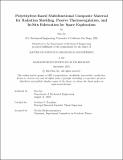Polyethylene-Based Multifunctional Composite Material for Radiation Shielding, Passive Thermoregulation, and In-Situ Fabrication for Space Exploration
Author(s)
Xu, Duo
DownloadThesis PDF (99.86Mb)
Advisor
Boriskina, Svetlana V.
Terms of use
Metadata
Show full item recordAbstract
Ionizing radiation sources like energetic electrons, protons, gamma rays, and secondary particles, such as thermal neutrons, are abundant in low Earth orbit (LEO) and deep space environments like lunar and Martian surfaces, where space missions are often conducted. Such sources of space radiation can induce severe damage to human tissue and critical electronic components, thereby posing significant risks to space exploration. Moreover, the absence of convection in space confines heat removal exclusively to thermal radiation, which negatively impacts the performance of electronic components, unless they are designed to function at elevated temperatures. Due to the considerably high cost of transporting materials and equipment to space, a cost-effective solution for mitigating ionizing radiation and overheating risks is crucial, especially for extended, deep-space missions. This thesis presents a polyethylene-based multifunctional composite material aiming to achieve simultaneous space radiation attenuation, passive thermoregulation, and in-situ fabrication.
The first component of the thesis explores the aspect of radiation shielding. While polyethylene is recognized as one of the best candidates for primary radiation shielding from Galactic Cosmic Rays (GCRs) and Solar Particle Events (SPEs), it does not adequately mitigate secondary particles. The proposed composite material, comprising polyethylene and boron-rich fillers, aims to match polyethylene's GCR and SPE performance while enhancing thermal neutron attenuation, the predominant secondary particle. The radiation shielding performance against GCR and SPE on the Martian surface is illustrated through a deterministic radiation transport simulation tool OLTARIS, and the performance of thermal neutron attenuation is demonstrated via a Monte Carlo particle transport tool PHITS and confirmed by EQ-SANS measurements.
The second component of the thesis addresses the feasibility of additive in-situ fabrication via fused deposition modeling (FDM). Due to the difficulties of FDM printing polyethylene, the development of reliable printing approaches has been shown to be a challenging task. In the thesis, a reliable printing process is reported for an optimized blend of different polyethylene resins, with or without various nanoparticles as dopants.
The third component focuses on passive thermoregulation performance. The optimized FDM printing process enables the fabrication of polyethylene with various fillers, hence providing design flexibility in filler selection, including compounds with boron and even other materials. With this flexibility, a coupled optics-heat transfer model has been developed to select materials providing both shielding and passive thermal regulation properties. This model accounts for the penetration of solar irradiation, power generation from inside, and temperature gradient across the layer, establishing the relationship between the optical properties of each material component and the temperature of the inner layer of the multifunctional material.
Although this thesis primarily targets extraterrestrial applications, the techniques developed in each component have broader applicability. For instance, the radiation transport simulation could be employed in other radiation environments such as nuclear reactors; the optimized FDM printing process allows for the additive manufacture of polyethylene, a versatile and affordable thermoplastic material not previously reliably fabricated; and the coupled optics-heat transfer model has broader applications such as thermal transport in multilayer systems characterized by significant temperature gradients and solar irradiation penetration.
Date issued
2023-09Department
Massachusetts Institute of Technology. Department of Mechanical EngineeringPublisher
Massachusetts Institute of Technology